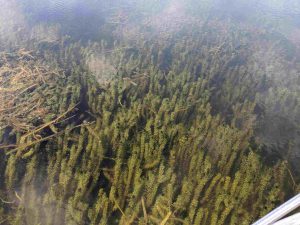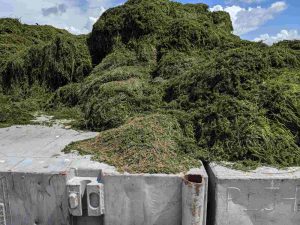By: Dr. James Leary, UF/IFAS Center for Aquatic and Invasive Plants Faculty
Mechanical harvesting aquatic plants is not a new concept. Increasingly larger and more efficient machines have been used in Florida to fight invasive plants for over a century. However, the use of these machines have declined in recent years as herbicide technology has improved. This trend has resulted in mechanical harvesting being seen as too slow and too expensive for wide-spread use. Is this perception truly the case? Is there enough data at real-world scales to know if harvesting is less efficient? Turns out, there is not enough data to answer the question. Therefore, in the summer of 2019, The University of Florida Institute of Food and Agricultural Sciences Center for Aquatic and Invasive Plants (UF/IFAS CAIP) began a project focused on re-evaluating the feasibility of harvesting hydrilla, a submersed invasive plant.
The Experiment

The experiment was conducted on Lake Tohopekaliga (Lake Toho), at operational scale. Lake Toho has the largest hydrilla infestation in the state of Florida. Every year the Florida Fish and Wildlife Conservation Commission (FWC) are tasked with treating more than 3,500 infested acres just to maintain 50% cover (i.e., ~9,000 acres of hydrilla). If this herbicide-based maintenance program is to be offset with mechanical harvesting operations, an optimal strategy is needed to compensate for managing large scale infestations of aquatic plants.

The research approach was to generate new data for mechanical harvesters operating on 329 acres of topped-out hydrilla. Since most of the data has been generated from small machines working in small research plots, researchers wanted to document the efficiency of large boats harvesting in real-world conditions. To track the pro
gress in real time, each harvester was fitted with GPS tracking devices, similar to those used on fleet delivery vehicles. The GPS tracking allowed researchers to know the precise speed and location of each harvester, down to the second, for every day of operation. Moreover, modified fish finders were used to determine how much hydrilla was harvested. Instead of looking for fish, these instruments look for plants and can accurately show how much hydrilla was present before and after each harvest.
At the end of the experiment, six harvesters worked for a total of 1,022 hours and covered 99% of the total project area. Harvesters, on average, cut 1.4 acres per hour. This speed was surprisingly consistent with previous (small-scale) research conducted in the 1970s and 80s. Modest reductions in hydrilla were observed during the experiment (June-August), but quickly increased by 40% one month after operations ceased (September).
The Future

Is mechanical harvesting the future of aquatic plant management? This is a question that has been asked many times over the decades. The summer of 2019 was one of the largest hydrilla harvest projects ever recorded. Based on the outcomes of this study, each acre of hydrilla would require between 5-9 harvester-hours to manage hydrilla and its rapid regrowth. Therefore, to continue managing 3,500 acres of hydrilla on Lake Toho would require 17,000-30,000 harvester-hours every year. Unfortunately, there is not currently enough harvesting equipment in Florida to meet this demand.
In order to make mechanical harvesters work, more research is needed to find new technologies to make harvesting more efficient and economical. Therefore, aquatic plant managers and researchers will need to put their heads together and devise new strategies to further improve aquatic plant management in Florida’s public lakes.
This project was funded by the Florida Fish and Wildlife Conservation Commission in an effort to enhance their aquatic plant management program. For a more comprehensive report please view the latest Winter 2019 issue of Aquatics Magazine at the Florida Aquatic Plant Management Society.
Dr. James Leary, UF/IFAS CAIP faculty member, wrote this piece. Any questions should be directed to Shelby Oesterreicher at soesterreicher@ufl.edu. For more information about the UF/IFAS Center for Aquatic and Invasive Plants, please visit http://plants.ifas.ufl.edu. Be sure to follow us on social @UFIFASCAIP.
UF/IFAS CAIP, Turning Science Into Solutions.
 0
0
